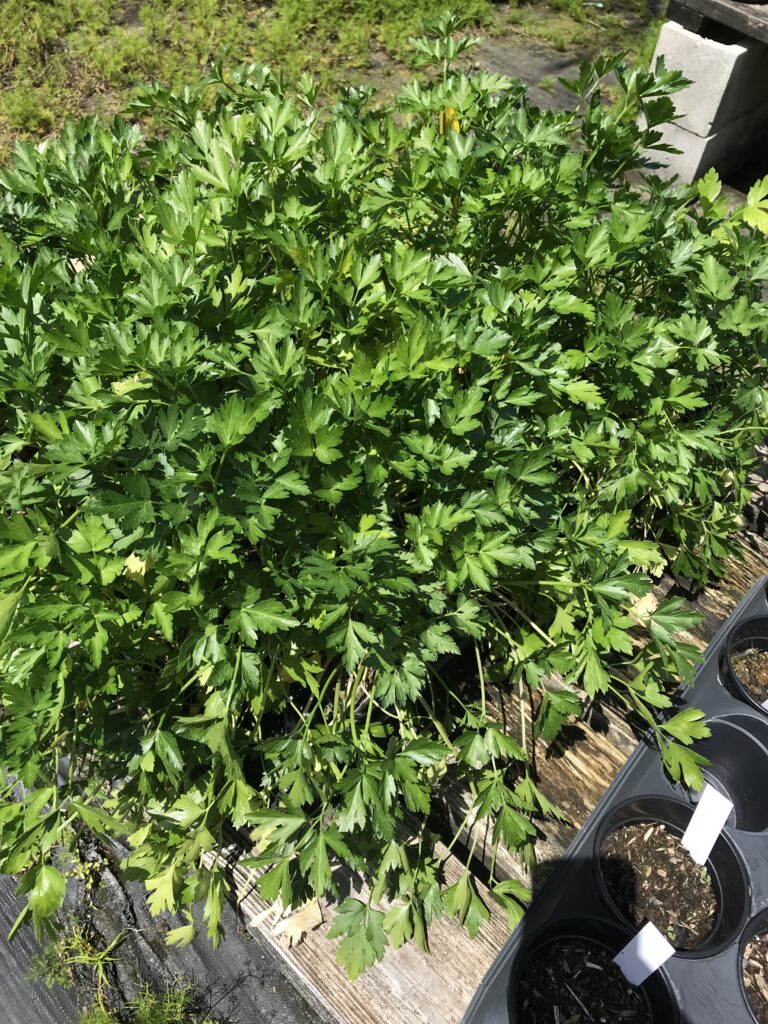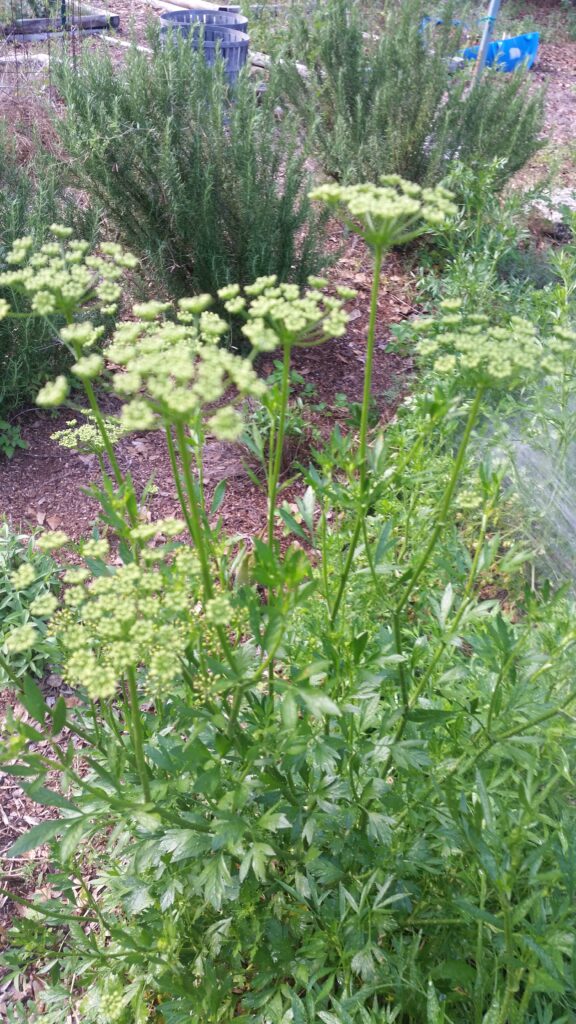Growing Parsley Herb Plants For Northeast Florida Gardens
(Petroselinum)
Parsley Herb Plants / Petroselinum For Northeast Florida Origins:
Parsley, both the ‘Plain/ Flat Leaf’ selections, most commonly referred to as ‘Italian Parsley’, the ‘Curled Leaf’ selections, as well as ‘Parsley Root’ or ‘Hamburg Parsley’, are native to the Mediterranean area.
According to the University of Florida’s publication “Parsley” European Colonists brought this wonderful herb to the Americas in the 17 th century. It continues to be one of the most commonly grown herb plants for home gardens today.
It’s is one of the easiest herbs to cultivate, even in Northeast Florida’s hot and humid gardens.
Parsley Herb / Petroselinum Growing Season for Northeast Florida:
Parsley grows great in Florida year round. It is a cool season biennial plant and can last more than one growing season when planted into the right spot. Parsley grown in Northeast Florida is most often planted as an annual from September to May.
Plant from seeds in fall at least 60 days before the first frost (October/November), or in early spring (February)for best results.
Sun Exposure for Parsley Herb / Petroselinum in Northeast Florida:
Plant Parsley in full sun, if you are growing it as an annual plant to discard after harvest when the weather begins to heat up during summer months.
Plant Parsley in a part shade / part sun exposure in our Jacksonville and St. Augustine Florida area landscapes if you are planning on keeping your parsley in ground for a season or two. I like to plant mine under the shade of a deciduous tree (like a Florida native Red Maple ) that will lose it’s leaves in the winter and expose my parsley to full sun during the cooler fall and early spring season when Parsley is at it’s best. I also find Parsley does well when planted under trees with a light canopy (like a native pine tree) that allows plenty of light to penetrate it’s foliage.
When planting parsley on a porch, patio, or as an indoor house plant, place them in a location to receive at least 4-6 hours of light each day.
Soil Preference for Parsley Herb / Petroselinum:
Moist, but well draining soils.
When planting Parsley into the ground, amend the soil generously with compost, it acts as a sponge and helps to keep the soil moist and well drained. Parsley planted into the ground during the summer months will suffer root rot during the rainy season if the soil is not well drained. (Planting under root thirsty trees will alleviate this problem, but you will have to remember to water well when not raining, just as you would with potted herbs).
Amend your planting site generously with compost when installing your new Parsley plants and each year in the early spring when keeping plants for more than one season.
Parsley lends itself to potted or container gardens well, as the plant and root system take up very little room. For best results allow parsley a 12 inch space in your container to grow.
Water and Fertilizer Requirements of Parsley Herb / Petroselinum Plants:
Newly planted seeds will require watering every day until the set of mature leaves emerges, then taper back to three times a week, then twice a week for in-ground plants and three to four times a week for potted containers.
I should note that Parsley planted into good quality compost requires very little attention to watering once it is rooted in. I have my Parsley planted into a 6 inch raised bed of compost and can leave it alone to survive on the local rains except when rainfall levels are low, during summer droughts, I supplement with weekly or semiweekly irrigation. It is, however, placed where it receives afternoon shade during the summer months from a nearby shade tree. If you have more summer sun or a confined root system in a small container and shared soils in a large mixed herb container = more water needed to keep plants thriving and healthy.
Don’t worry if all that sounds too complicated, I have found Parsley to be very forgiving and bounced right back from neglect with a little attention to water and fertilizing.
In general, herbs require little in the way of fertilizer. To much fertilizer with herbs can be worse than not enough. Over fertiliztion can lead to lush green growth with a reduced quantity of volatile oils in the leaves. Reduced oils, means reduced flavor and aroma in your herbs.
However, in Florida’s sandy soils you may find your plants in some need of som help, particularly if compost wasnt added to the soil when planting. Try fertilizing with a mixture of fish emulsions and seaweed at one ounce of each per gallon of water. Put into a sprayer and water every other week or as needed with the mixed solution.
If you find your plant struggling at any point, make up a batch of compost tea and water generously. Repeat as needed weekly or biweekly.
Size of Parsley / Petroselinum When Mature:
The mature size on a parsley plant may surprise you, they can grow up to 2 ft high and wide if planted into a good location, and are a fairly fast growing herb selection.Sowing Parsley Herb / Petroselinum Seeds into Northeast Florida Soils:
Parsley is notorious for being slow to germinate. One of my favorite garden Authors, Tom MacCubbin, says it best in his book ‘The Edible Landscape’. When answering a question on how long it takes to sprout Parsley seeds he says this..”According to plant lore, parsley must go to the devil and back seven times before it will come up.”

To help speed the process along, consider soaking your seeds in a bowl of warm water overnight before planting out into the garden the next day. Then help your seeds stay moist util germinating by covering the soil with a thin layer of newspaper or a clear plastic sandwich bag until you see sprouts. Once your seeds have sprouted, remember to water every day for a few days, then every other day for a few days, and then finally change your watering schedule to two to three times per week once your plants have developed mature leaves. There are plenty of tips and tricks out there for speeding seed germination, but even with help you can safely expect two to three weeks for your seeds to sprout.
Sow your seeds 1/4 th of an inch below the soil surface and remember to thin them to at least one plant every six inches in a row, parsley dislikes being cramped and will grow much more vigorously given some room.
Harvesting Your Parsley / Petroselinum in the Northeast Florida Landscape:
Parsley can be harvested in as little as 60 days from seeding into the soil. Remove the lower leaves just above ground level for best results.
Parsley, when dried slowly, makes an excellent dried herb to add a quick boost of flavor to soups, potatoes, pasta sauce, etc. I like to use an inexpensive dehydrator when I find I have more on hand than I need to use fresh. But if you don’t have one handy it’s just a matter of following a few simple steps. First make sure to wash and hand dry your herbs fresh cut from the garden. Next take some string, fishing line, or twine and tie a little bundle of Herbs together at the stalks. Hang it from a coat hanger in a doorway by the sting, and wait for it to dry. When it crumbles in your fingers when you touch it, you’re done!
Blooms and Seeds of Parsley Herb / Petroselinum for Northeast Florida Landscape:

When growing Parsley as an annual, or after harvesting for a few seasons, you can stop cutting your Parsley leaves in summer, and allow your plant to go to flower so that it will set seeds. Some say that the Parsley that comes up this way always seem to be the best!
Seeds are small and short lived. Store them in an airtight container or bag in the crisper of your refrigerator if planning to sow seeds the following year.

